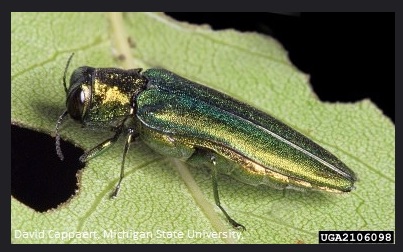Source: Texas A&M Forest Service | May 29, 2020
The presence of the deadly emerald ash borer (EAB) was confirmed May 19, 2020, in Denton and Bowie Counties. EAB has infested and killed ash trees in both counties, soon adding them to the list of Texas jurisdictions to be placed under the Texas Department of Agriculture’s (TDA) wood transportation quarantine on EAB.

On May 15, Denton City forester Haywood Morgan collected an insect sample from a neighborhood near I-35E, and in coordination with Texas A&M Forest Service, sent it to the USDA Department Animal and Plant Health Inspection Service (APHIS) national lab for confirmatory identification.
On May 14, in Bowie County, adult EAB specimens were caught in Texas A&M Forest Service detection traps and sent to the USDA national lab. Texas A&M Forest Service set traps and proactively monitors for the emerald ash borer each year.
“Since 2018, we have deployed nearly 500 traps across Central, East and North Texas annually watching for the insect’s presence and movement,” said Allen Smith, Texas A&M Forest Service Regional Forest Health Coordinator. “Both healthy and unhealthy ash trees are susceptible to EAB attack and have no natural resistance to the exotic insect. Without forest management mortality can be 100% in heavily infested areas – so early detection could improve our chances to manage for the pest.”
Lab results for both specimens tested positive as EAB.
“In Denton, the urban forest has an approximate a 4% ash component, but the neighborhood where the detection was made the ash component is about 20%” said Courtney Blevins, Texas A&M Forest Service urban forester. “Some streets much have a higher percentage and some lower, but many trees in the affected area are already infested.”
The state’s mandatory quarantine by TDA, restricts movement of any woody ash material exiting the county or quarantined area.
According to Smith, there is no stopping EAB, but the quarantine helps slow the beetle’s spread by restricting the movement of wood in and out of affected areas. The insect often is transported unintentionally on firewood and other wood.
All species of ash are susceptible to the destructive EAB. Infested trees die within two to five years after infestation. Texas A&M Forest Service urban tree canopy inventories estimate that ash trees comprise approximately 5% of the Dallas/Fort Worth urban forest and approximately 1% of the standing inventory forests in East Texas.
“There is no known stop to this epidemic,” said Texas A&M Forest Service Urban Forester Courtney Blevins. “But we can help communities minimize loss, diversify their tree species and contribute to the health and resiliency of their urban forests.”
Texas A&M Forest Service has resources available to help affected communities identify signs of EAB infestation, as well as make decisions about preventative measures they can take and how to handle tree management and removal.
The agency will work with communities on state and federal quarantines of the movement of wood into and out of the area. These quarantines are standard protocols with such infestations and in Texas are set by TDA.
For more information on EAB in Texas, please visit http://texasforestservice.tamu.edu/eab/.
EAB photos and resources can be viewed and accessed at http://ow.ly/LIJi30lbBxz
For information from TDA on EAB quarantine, visit https://www.texasagriculture.gov/RegulatoryPrograms/PlantQuality/PestandDiseaseAlerts/EmeraldAshBorer.aspx.
To report emerald ash borer, please call 1-866-322-4512.
